Mining in Cornwall
Tin working in Cornwall began in the Bronze Age, where veins of ore were exposed by streams cutting across the moors.. Tin is one of the components of bronze, and for more than 2,000 years, tin mining was a major industry in Cornwall. Even before the birth of Christ, Cornish traders were exporting to Europe and the Roman Empire. The brasswork in King Solomon's Temple is said to have been wrought from Cornish tin, and an old legend has it that Christ himself visited Cornwall with his uncle, Joseph of Arimathaea, a merchant who came to buy tin.
The name "Wheal" which prefixes many Cornish mine names comes from
the Cornish word "whel", which means "tin mine". Sadly, the
once great Cornish tin industry is now defunct - the last one to close being
South C rofty
near Helston. However, preserved workings can still be seen, such as at the
Poldark Mine.
rofty
near Helston. However, preserved workings can still be seen, such as at the
Poldark Mine.
Years ago, the "tinners" were granted special privileges in Cornwall because of their contribution to the economy. Their history is packed with odd traditions and tales. In particular they were very wary about the spirits who lived in the mines - the knockers, buccas (imps) and spriggans. Stories of disembodied hands carrying candles, spirit voices warning of impending rock falls and ghostly black dogs and white hares prophesying certain disaster abound throughout Cornwall – perhaps not too surprising, as flickering candlelight was the tinners' only illumination until Cornishman Sir Humphry Davy invented his Miner's Lamp!
Men, women and children worked in the mines. Women ('bal-maidens') did many of the above-ground tasks, and small children would fetch and carry and do odd jobs. At 12 years old, they could join their fathers underground. As the mines grew larger and more prosperous in the early 19thC, mining became a family tradition in the main mining areas such as West Penwith, where the granite rock masses yielded the largest amounts of tin and copper. Very little was wasted, and by-products included lead and arsenic. Cornish "hard-rock" men were in great demand wherever strength, stamina and skill were needed.
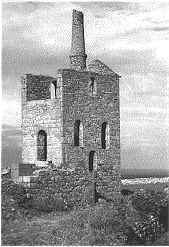 By
our standards, life for the miner and his family was very hard. Cottages were
tiny, perhaps with only one room and a sleeping loft in the rafters for the
children. Water had to be fetched from the local pump, and the garden provided
the bulk of the food in the summer, with potatoes being the staple item. Most
miners also kept a few chickens and a cow for eggs and milk. On the coast, there
were also fish to catch, and it was not unusual for several men to have shares
in a small boat and to lay nets and crab pots.
By
our standards, life for the miner and his family was very hard. Cottages were
tiny, perhaps with only one room and a sleeping loft in the rafters for the
children. Water had to be fetched from the local pump, and the garden provided
the bulk of the food in the summer, with potatoes being the staple item. Most
miners also kept a few chickens and a cow for eggs and milk. On the coast, there
were also fish to catch, and it was not unusual for several men to have shares
in a small boat and to lay nets and crab pots.
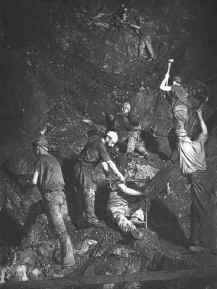 Looking
after the garden and animals and going fishing were spare time occupations.
Considering the length of the miner's working day and the arduous nature of the
work, we can only wonder at their stamina. There were 3 eight-hour daily shifts
("cores") in the mines from 0600, 1400 and 2200 hrs. Many men walked
up to 5 miles to the mine from their homes and, after climbing down hundreds of
yards of vertical ladders, walked a further mile or two to actually began work.
After 8 hours of backbreaking work in hot, cramped and frequently wet
conditions, they had to do it all again in reverse to get home.
Looking
after the garden and animals and going fishing were spare time occupations.
Considering the length of the miner's working day and the arduous nature of the
work, we can only wonder at their stamina. There were 3 eight-hour daily shifts
("cores") in the mines from 0600, 1400 and 2200 hrs. Many men walked
up to 5 miles to the mine from their homes and, after climbing down hundreds of
yards of vertical ladders, walked a further mile or two to actually began work.
After 8 hours of backbreaking work in hot, cramped and frequently wet
conditions, they had to do it all again in reverse to get home.
It was pitch black underground except for pools of light thrown by candles
stuck  to
the front of their canvas hats or placed on ledges on the walls. Men bought
their own candles and tools and, when pay day came, were often in debt for them
to the mine owner. There were several ways of earning money, but generally, a
miner was paid for the quality and quantity of good ore brought to the surface.
If he was fortunate, and had a dry, workable pitch with rich lodes, he could
earn a living wage; otherwise, he took home very little.
to
the front of their canvas hats or placed on ledges on the walls. Men bought
their own candles and tools and, when pay day came, were often in debt for them
to the mine owner. There were several ways of earning money, but generally, a
miner was paid for the quality and quantity of good ore brought to the surface.
If he was fortunate, and had a dry, workable pitch with rich lodes, he could
earn a living wage; otherwise, he took home very little.
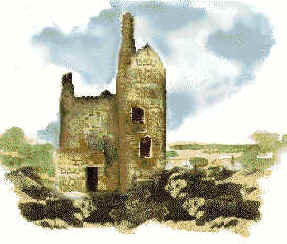 The
novelist R M Ballantyne spent six months in Penwith, and from his experiences
wrote "Deep Down: a Tale of the Cornish Mines". Ballantyne obviously
admired the stoic courage and persistence of the Cornish miners, who in the
main, got so little for their toil. "Few of them retain health or strength
sufficient to go underground beyond the age of 45, while hundreds of them find
an early grave, owing to disease resulting from their peculiar work, or to
accidents. These last are usually occasioned by the bursting out of collections
of water which flood the mines; or the fall of masses of timber; or the
premature explosion of blast holes. At other times, the men lose hold of the
ladders - "fall away" from them, as they expressed it - or stumble
into a 'winz', which was a small shaft connecting various levels, in which case,
death is almost certain to ensue, many of the winzes being 60 feet deep."
The
novelist R M Ballantyne spent six months in Penwith, and from his experiences
wrote "Deep Down: a Tale of the Cornish Mines". Ballantyne obviously
admired the stoic courage and persistence of the Cornish miners, who in the
main, got so little for their toil. "Few of them retain health or strength
sufficient to go underground beyond the age of 45, while hundreds of them find
an early grave, owing to disease resulting from their peculiar work, or to
accidents. These last are usually occasioned by the bursting out of collections
of water which flood the mines; or the fall of masses of timber; or the
premature explosion of blast holes. At other times, the men lose hold of the
ladders - "fall away" from them, as they expressed it - or stumble
into a 'winz', which was a small shaft connecting various levels, in which case,
death is almost certain to ensue, many of the winzes being 60 feet deep."
There was always danger; rocks fell from the roofs, tunnels caved in, explosions caused disasters, and rotten ladders and planks threw many a miner to his death in deep holes and shafts. Medical services were primitive and expensive, and a miner too badly injured to work had to rely on charity. Every mining village had its little band of cripples sitting forlornly in the village square as a grim reminder of the cost of tin and copper. Surprisingly, however, they were generally cheerful. At a time when all life was hard, they did not consider themselves to be worse off than most. They sang on the way to work, and in the churches and chapels on Sundays; they had a natural ability to harmonise, and the sound of scores of men singing favourite hymns in harmony is well remembered by the older people of Cornwall.
In the earliest gravel or stream works, the water was carried out in wooden
bowls, or was carried off from the 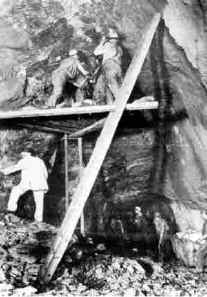 working
in a ' level', or trench, leading from the work to the river. However, by the
end of the 16thC, a period of shallow diggings in the stanniferous gravel
being worked out, shaft mining into the bedrock made mechanical mining
improvements essential in order to go deeper underground. Techniques were still
primitive; they used picks, hammers and iron wedges, sometimes heating the rock
surface by fire to split it open. (Gunpowder was introduced, with several tragic
results, in 1689.) Some mines reached a depth of 300 ft, and German engineers
were employed to drain the workings: adits were driven into hillsides, and
windlasses and water wheels were used to power pumps. The adit was similar to
the level only driven through the hill-side to meet the shaft at its foot. This
last was expensive and temporary, because as soon as the shaft was driven deeper
additional apparatus had to be used to raise the drainage to the level of the
adit. Various mechanical pumping devices worked by man-power were also tried,
but the severity of labour they entailed on the men working them made them
unsatisfactory and costly. Water wheels were used in some mines, but as their
power was limited a deep mine needed two or three wheels, one above the other,
to clear it effectively.
working
in a ' level', or trench, leading from the work to the river. However, by the
end of the 16thC, a period of shallow diggings in the stanniferous gravel
being worked out, shaft mining into the bedrock made mechanical mining
improvements essential in order to go deeper underground. Techniques were still
primitive; they used picks, hammers and iron wedges, sometimes heating the rock
surface by fire to split it open. (Gunpowder was introduced, with several tragic
results, in 1689.) Some mines reached a depth of 300 ft, and German engineers
were employed to drain the workings: adits were driven into hillsides, and
windlasses and water wheels were used to power pumps. The adit was similar to
the level only driven through the hill-side to meet the shaft at its foot. This
last was expensive and temporary, because as soon as the shaft was driven deeper
additional apparatus had to be used to raise the drainage to the level of the
adit. Various mechanical pumping devices worked by man-power were also tried,
but the severity of labour they entailed on the men working them made them
unsatisfactory and costly. Water wheels were used in some mines, but as their
power was limited a deep mine needed two or three wheels, one above the other,
to clear it effectively.
In Charles I’s reign, there were complaints that the increased cost of drainage, added to the increased cost of materials, had brought about a period of great depression, and it was noted that both capital and labour were leaving mining for husbandry. Because of these difficulties, one pit after another was being drowned out and the future of the industry seemed very precarious.
In 1710, John Costar successfully used a single large water-wheel to drain some of the deeper mines. His invention, however, was quite overshadowed by that of the steam engine, which resulted in a major change in the
tin-mining industry. The first shallow diggings had been worked by ordinary
workmen with little or no capital, but as the mines became deeper, greater
investment was required to sink the shafts and keep them clear of wate. This
meant the involvement of a new class of men from outside the mining districts,
or at any rate distinct from the ordinary miners, who were induced to venture
their money in the mines. Unfortunately, many mines were not well managed, and
when difficulties arose, investors often withdrew their cash, and if a mine
owner had to spend months searching for fresh lodes without earning a profit,
money often ran out, resulting in closure, flooding and unemployment.
the
tin-mining industry. The first shallow diggings had been worked by ordinary
workmen with little or no capital, but as the mines became deeper, greater
investment was required to sink the shafts and keep them clear of wate. This
meant the involvement of a new class of men from outside the mining districts,
or at any rate distinct from the ordinary miners, who were induced to venture
their money in the mines. Unfortunately, many mines were not well managed, and
when difficulties arose, investors often withdrew their cash, and if a mine
owner had to spend months searching for fresh lodes without earning a profit,
money often ran out, resulting in closure, flooding and unemployment.
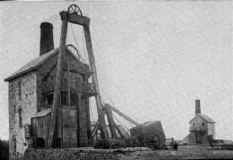 It
was steam power that eventually made deep mining possible. Greater power being
available, shafts were sunk much lower than ever before, enabling copper, rather
than tin, to be extracted - copper was then in great demand for everything from
kettles and kitchenware to copper-bottomed sailing ships. (More money was
actually made from mining copper than tin in Cornwall).
It
was steam power that eventually made deep mining possible. Greater power being
available, shafts were sunk much lower than ever before, enabling copper, rather
than tin, to be extracted - copper was then in great demand for everything from
kettles and kitchenware to copper-bottomed sailing ships. (More money was
actually made from mining copper than tin in Cornwall).
West Cornwall, full of working mines with their granite stacks, was the hub
of the Industrial Age, especially in the area south of Redruth. From 1801 to
1830, Cornish mines produced on average two-thirds of the total world 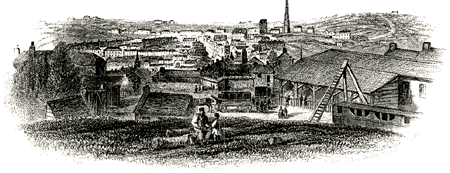 production
of fine copper, and their prosperity peaked between 1850 and 1865, when most of
the world's tin and copper came from the county. However, after this time,
enormous deposits of tin and copper were discovered abroad, eventually resulting
in the destruction of the Cornish mining industry and the emigration of
thousands of miners and their families to the new world.
production
of fine copper, and their prosperity peaked between 1850 and 1865, when most of
the world's tin and copper came from the county. However, after this time,
enormous deposits of tin and copper were discovered abroad, eventually resulting
in the destruction of the Cornish mining industry and the emigration of
thousands of miners and their families to the new world.
Levant & Geevor
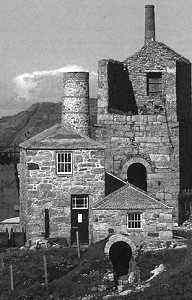
One of the greatest mines of the St. Just mining area was Levant on the Pendeen
coast, The mine opened in 1820 and closed in 1930. It has 60 miles of tunnels
beneath the seabed. When Levant closed, the massive steam engine that was used
to raise ore and to pump water from the depths of the mine, survived. The engine
has been restored by the preservation group the Trevithick Society and is housed
in the National Trust's restored engine house at Levant.
Adjoining Levant is Geevor Mine, a treasure house of industrial archaeology. Geevor was the last working mine in the area, but closed in 1990. Now it is the site of an outstanding mine heritage centre.
Celia Feinnes - 1698. "I went a mile further and soe came where they were digging in the Tinn mines. there was at least 20 mines all in sight which employs a great many people at work, almost night and day, but constantly all and every day includeing the Lords day which they are forced to, to prevent the mines being overflowed with water; more than 1000 men are taken up about them, few mines but had then almost 20 men and boys attending to it either down the mines digging and carrying the oare to the little bucket which conveys it up, or else others are draineing the water and looking to the engines that are draineing it, and those above are attending the drawing up the oare in a sort of windlass as it is to a well; two men keeps turning bringing up one and letting down another, they are much like the leather buckets they use in London to put out fire which hang up in churches and great mens halls; they have great labour and great expense to draine the mines of the water with mills that horses turn and now they have the mills or water engines that are turned by the water, which is convey'd on frames as timber and truncks to hold the water, which falls down on the wheeles, as an over shott mill - and these are the sort that turns the water into severall towns I have seen about London Darby and Exeter, and many places more; they do five tymes more good than the mills they use to turn with horses, but then they are much more chargeable; those mines do require a great deale of timber to support them and to make all these engines and mills, which makes fewell very scarce here; they burn mostly turffs which is an unpleasant smell, it makes one smell as if smoaked like bacon; this oar is made fine powder in a stamping mill which is like the paper mills, only these are pounded drye and noe water let into them as is to the raggs to work them into a paste; the mills are all turned with a little streame or channell of water you may step over; indeed they have noe other mills but such in all the country, I saw not a windmill all over Cornwall or Devonshire tho' they have wind and hills enough, and it may be its too bleake for them."